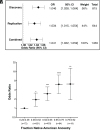Genetic risk factors for Mesoamerican nephropathy
- PMID: 39585978
- PMCID: PMC11626114
- DOI: 10.1073/pnas.2404848121
Genetic risk factors for Mesoamerican nephropathy
Abstract
Mesoamerican nephropathy (MeN) is a progressive kidney disease found on the Pacific coast of Central America primarily in young male agricultural workers without typical kidney disease risk factors. While it is generally accepted that environmental exposures contribute to MeN, we hypothesized that there was also an important genetic component. We performed a genome-wide association study comparing individuals with MeN versus individuals with normal kidney function. We found that Native American ancestry was strongly associated with increased risk of MeN. We also identified candidate variants in the OPCML gene, which encodes a protein that binds opioid receptors, that were associated with ~sixfold reduced odds of MeN (allele frequency 0.029 in controls and 0.005 in cases, OR = 0.16; P = 4 × 10-8). Sugarcane workers with the protective OPCML variants had markedly increased urine osmolality suggesting greater ability to defend against hypovolemia. Experiments with Opcml knock-out mice revealed roles for OPCML in fluid balance and temperature regulation consistent with our findings in humans. Our data suggest that heritable differential sensitivity to heat stress and dehydration contributes to high rates of kidney disease in Central America.
Keywords: Mesoamerican; OPCML; genetics; kidney disease.
Conflict of interest statement
Competing interests statement:The authors declare no competing interest.
Figures



References
-
- Cohen J., Mesoamerica’s mystery killer. Science 344, 143–147 (2014). - PubMed
-
- Ordunez P., et al. , The epidemic of chronic kidney disease in Central America. Lancet Glob. Health 2, e440–e441 (2014). - PubMed
-
- Johnson R. J., Wesseling C., Newman L. S., Chronic kidney disease of unknown cause in agricultural communities. N. Engl. J. Med. 380, 1843–1852 (2019). - PubMed
-
- Chatterjee R., Occupational hazard. Science 352, 24–27 (2016). - PubMed
MeSH terms
Grants and funding
LinkOut - more resources
Full Text Sources
Molecular Biology Databases

